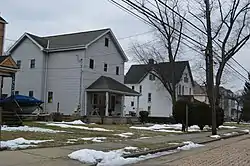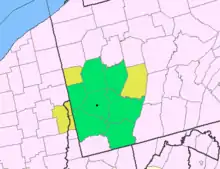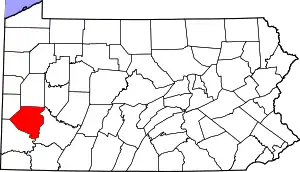Glenfield, Pennsylvania
Glenfield is a borough in Allegheny County, Pennsylvania, along the Ohio River. The population was 205 at the 2010 census.[3]
Glenfield, Pennsylvania | |
|---|---|
 Houses on East Beaver Street | |
 Location in Allegheny County and the U.S. state of Pennsylvania. | |
| Coordinates: 40°31′9″N 80°7′55″W | |
| Country | United States |
| State | Pennsylvania |
| County | Allegheny |
| Government | |
| • Type | Board of Commissioners |
| • Mayor | Roger Zingerman (R) |
| • President of Council | Robert Brown (R) |
| Area | |
| • Total | 0.99 sq mi (2.56 km2) |
| • Land | 0.82 sq mi (2.12 km2) |
| • Water | 0.17 sq mi (0.44 km2) |
| Population (2010) | |
| • Total | 205 |
| • Estimate (2019)[2] | 201 |
| • Density | 245.12/sq mi (94.66/km2) |
| Time zone | UTC-5 (Eastern (EST)) |
| • Summer (DST) | UTC-4 (EDT) |
| FIPS code | 42-29592 |
| Website | www |
Geography
Glenfield is located at 40°31′9″N 80°7′55″W (40.519068, -80.131823).[4]
According to the United States Census Bureau, the borough has a total area of 1.0 square mile (2.6 km2), of which 0.9 square miles (2.3 km2) is land and 0.2 square miles (0.52 km2), or 16.00%, is water.
Surrounding and adjacent neighborhoods
Glenfield has three land borders, including Aleppo Township to the north, Kilbuck Township to the east, and Haysville to the west. Across the Ohio River's main channel, Glenfield runs adjacent with the western end of Neville Island (Neville Township).
Education
Glenfield is served by the Quaker Valley School District
Government and Politics
| Year | Republican | Democratic | Third Parties |
|---|---|---|---|
| 2016 | 58% 62 | 38% 41 | 4% 4 |
| 2012 | 61% 60 | 38% 38 | 1% 1 |
Taxes
School tax millage rate- The Quaker Valley SD (shared with twelve other municipalities) in 2017 was 18.40. This ranked 35th highest/most expensive out of Allegheny County's 45 school districts, between West Allegheny SD (34th highest) and North Allegheny SD (36th highest).[7]
Demographics
| Historical population | |||
|---|---|---|---|
| Census | Pop. | %± | |
| 1880 | 538 | — | |
| 1890 | 718 | 33.5% | |
| 1900 | 905 | 26.0% | |
| 1910 | 984 | 8.7% | |
| 1920 | 976 | −0.8% | |
| 1930 | 950 | −2.7% | |
| 1940 | 911 | −4.1% | |
| 1950 | 870 | −4.5% | |
| 1960 | 741 | −14.8% | |
| 1970 | 406 | −45.2% | |
| 1980 | 246 | −39.4% | |
| 1990 | 241 | −2.0% | |
| 2000 | 236 | −2.1% | |
| 2010 | 205 | −13.1% | |
| 2019 (est.) | 201 | [2] | −2.0% |
| Sources:[8][9][10][11][12][13][14] | |||
As of the census[13] of 2000, there were 236 people, 90 households, and 60 families residing in the borough. The population density was 278.7 people per square mile (107.2/km2). There were 96 housing units at an average density of 113.4 per square mile (43.6/km2). The racial makeup of the borough was 96.19% White, 2.54% African American, 0.85% Native American, and 0.42% from two or more races. Hispanic or Latino of any race were 0.42% of the population.
There were 90 households, out of which 33.3% had children under the age of 18 living with them, 52.2% were married couples living together, 12.2% had a female householder with no husband present, and 33.3% were non-families. 30.0% of all households were made up of individuals, and 14.4% had someone living alone who was 65 years of age or older. The average household size was 2.62 and the average family size was 3.30.
In the borough the population was spread out, with 30.5% under the age of 18, 4.7% from 18 to 24, 26.3% from 25 to 44, 21.6% from 45 to 64, and 16.9% who were 65 years of age or older. The median age was 38 years. For every 100 females, there were 91.9 males. For every 100 females age 18 and over, there were 92.9 males.
The median income for a household in the borough was $38,750, and the median income for a family was $43,250. Males had a median income of $37,500 versus $23,333 for females. The per capita income for the borough was $16,123. About 4.8% of families and 4.8% of the population were below the poverty line, including 4.3% of those under the age of eighteen and none of those sixty five or over.
References
- "2019 U.S. Gazetteer Files". United States Census Bureau. Retrieved July 28, 2020.
- "Population and Housing Unit Estimates". United States Census Bureau. May 24, 2020. Retrieved May 27, 2020.
- "Race, Hispanic or Latino, Age, and Housing Occupancy: 2010 Census Redistricting Data (Public Law 94-171) Summary File (QT-PL), Glenfield borough, Pennsylvania". United States Census Bureau. Retrieved September 19, 2011.
- "US Gazetteer files: 2010, 2000, and 1990". United States Census Bureau. 2011-02-12. Retrieved 2011-04-23.
- EL. "2012 Allegheny County election". Pittsburgh Tribune-Review. Retrieved 15 October 2017.
- EL. "2016 Pennsylvania general election results". Pittsburgh Post-Gazette. Retrieved 15 October 2017.
- EL. "Allegheny County Treasurer". Retrieved 1 September 2017.
- "Population of Civil Divisions Less than Counties" (PDF). 1880 United States Census. U.S. Census Bureau. Retrieved 24 November 2013.
- "Population-Pennsylvania" (PDF). U.S. Census 1910. U.S. Census Bureau. Retrieved 22 November 2013.
- "Number and Distribution of Inhabitants:Pennsylvania-Tennessee" (PDF). Fifteenth Census. U.S. Census Bureau.
- "Number of Inhabitants: Pennsylvania" (PDF). 18th Census of the United States. U.S. Census Bureau. Retrieved 22 November 2013.
- "Pennsylvania: Population and Housing Unit Counts" (PDF). U.S. Census Bureau. Retrieved 22 November 2013.
- "U.S. Census website". United States Census Bureau. Retrieved 2008-01-31.
- "Annual Estimates of the Resident Population". U.S. Census Bureau. Archived from the original on 19 October 2013. Retrieved 22 November 2013.

